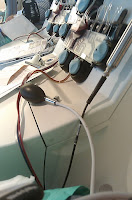| It's easy! |
If you could help save a life by simply giving an hour of your time, would you?
I learned about the importance of platelet donation after my sister was diagnosed with acute myeloid leukemia in October 2010. With the help of God, the support of family and friend, a great team of doctors and nurses and the donors who gave their blood and platelets, my sister is thriving. After noticing the UNC Health Care Blood Donation Center after my sister received a platelet transfusion for the third time in a row, I decided to learn more about the process and made an appointment to donate some of my own platelets. The staff was very friendly, helpful and professional. They made the donation process a pleasure and something I look forward to doing again.
My Donation Experience
 |
| My arm: one poke, three tubes |
After speaking with the nurse, I picked out a movie, a snack and a couple of beverages. I sat in a comfortable lounge chair and put my right arm over a warm heating pad. A different nurse had me squeeze a warm stress ball full of gel and tied a tourniquet around my right bicep. She then said, “Squeeze the ball twice, and hold,” so I did. She then cleaned my skin and told me to breathe in as she stuck a needle in my arm. The needle didn’t hurt; I thought the nurse was scratching me with a cleansing pad when she stuck me.
 |
| Separating my platelets |
Facts about Platelet Donations:
| How it works |
- In 2009 UNC Health Care used an average of 350 platelets per month. However, the UNC Health Care's Blood Donation Center collects only 210 platelets a month.This deficit of platelets is seen in hospitals throughout the U.S.
- It takes six to eight bags of donated blood to fill one bag of platelets. However, you can donate just platelets.
- When you donate just platelets, you are only poked with one needle and the blood taken from you is returned with the same needle.
- A lack of platelets in a cancer patient can cause bruising, hemorrhaging of the eyes, the inability for wounds to heal and blood blisters in the mouth.
- It only takes an hour to donate platelets.
- You can donate platelets every two weeks.
- Blood type does not matter when it comes to donations.
- Check with your local donation center to see if you are eligible to donate platelets.
 |
| My platelets |
Save a life today.
Tweet